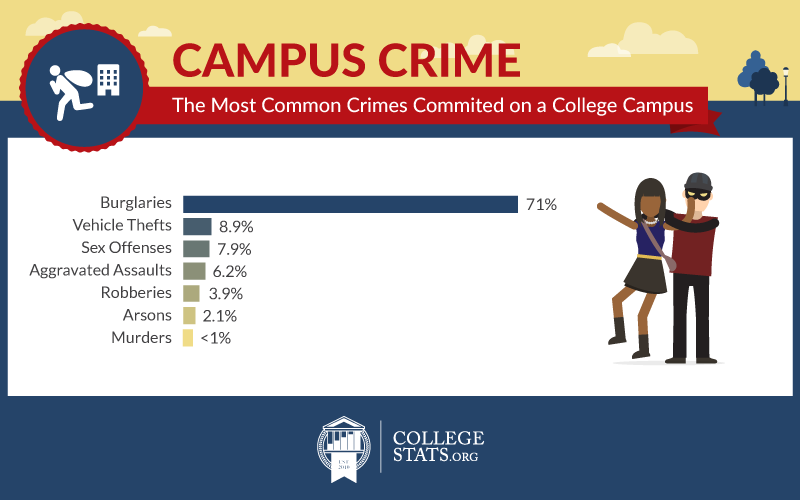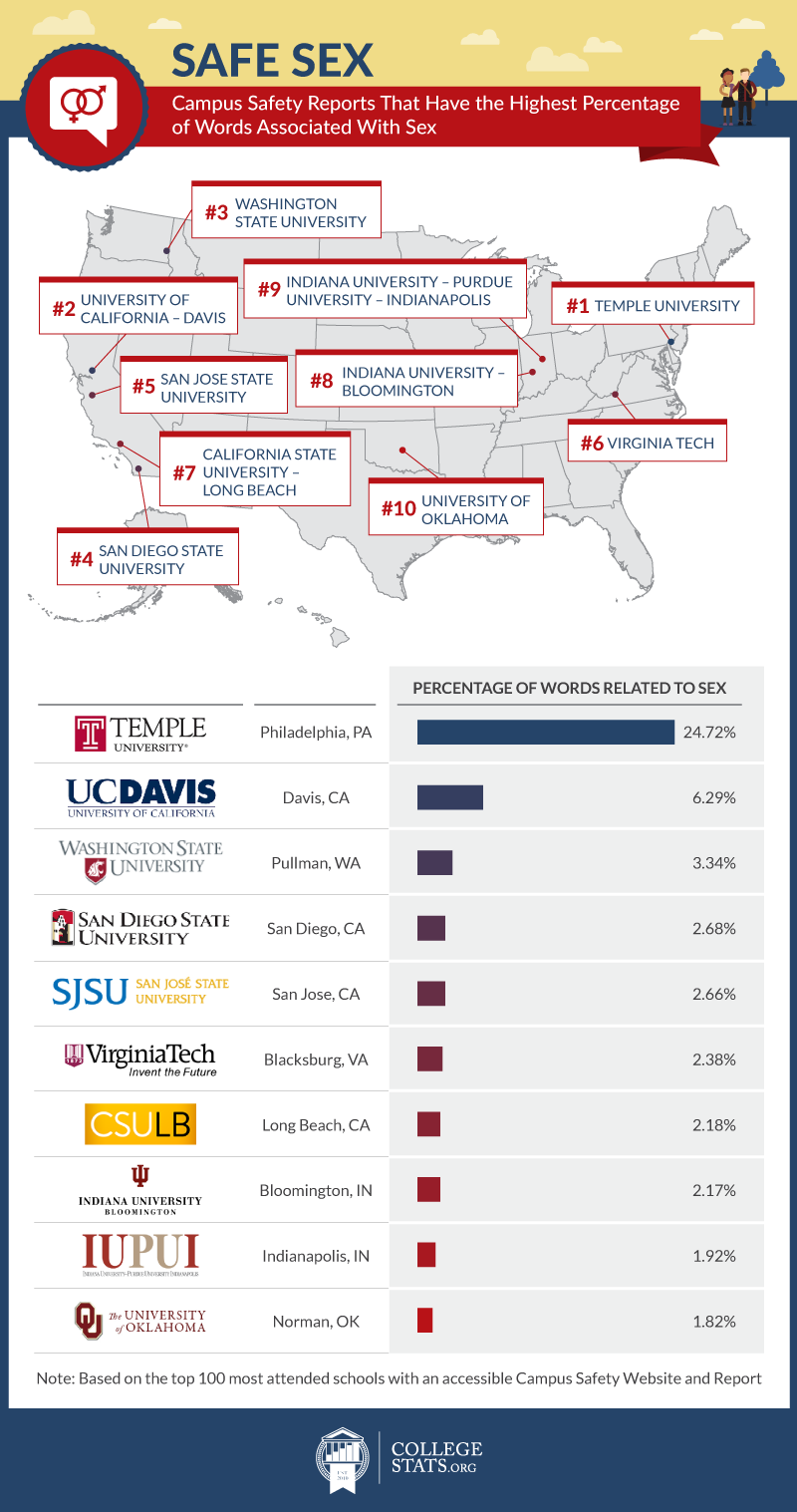Going to college can be one of the most exciting times in a person’s life. You’ve graduated high school and may be moving out to start on a path that will lead to your professional career. Ranking top university choices by campus environment, academic notoriety, and overall location makes sense. These play a large part in deciding where to spend one’s pivotal years. But what about campus safety?
We compiled a list of the 100 most attended universities and colleges and used a survey that questioned over 179,000 different students to find out how their school’s security stacks up. We looked at safety reporting, analyzed what students were most concerned about, and determined how secure they felt at school. Having a famous football program or Ivy League prestige is nice, but how can you enjoy those things if you feel vulnerable?
What’s On Students’ Minds
When asked what their primary safety concerns were at their college or university, the majority replied with a simple answer: They had none. In fact, almost 29 percent of students said they didn’t feel like they had anything to worry about at school – other than project deadlines and final exams, of course.
However, nearly 28.5 percent of students said they were concerned about excessive drinking. While the legal drinking age in the U.S. is 21, the rate of binge drinking among college students has increased significantly in the last several years. (Most students enter college between the ages of 18 and 19.) Heavy drinking can potentially lead to blacking out, overdosing, motor vehicle accidents, and even death.
Other primary concerns include walking alone, unlit pathways, and theft or robberies. Despite recent media attention on the subject, only a little over 2 percent of students surveyed said they were worried about rape or sexual assault.
Not on Our Watch
One of the clearest indicators of safety on a college campus is the rate of crime.
Of the 100 schools that we looked at, Clemson University, in South Carolina, had the lowest rate of crime by far. Beyond just having a safety website that students can access, they also have a school safety Twitter account with over 6,000 followers that regularly updates with alerts and pictures of known assailants.
Three colleges in New York: The Fashion Institute of Technology, CUNY York College, and The New York Institute of Technology also ranked in the top 10 for lowest crime rates. Like New York City where crime is also at a record low, these campuses also managed to keep incidences severely reduced. Safer campuses with lower rates of crime equal safer students with less to worry about.
Always Watching
Police visibility may be one of the biggest deterrents to crime and vandalism. Knowing that law enforcement is always nearby may change a person’s motive or even stop impulsive crimes from occurring.
Concordia University in Ann Arbor, Michigan, was voted by students as having the most visible police presence of the 100 surveyed schools. Its campus safety website indicates the direct number for the current on-duty officer as well as the location of the security office, indicating that communication between students, the police, and the security team is deeply encouraged
The University of Connecticut at Waterbury came in just under Concordia as having the second greatest police presence. Its safety website also prominently features contact information for campus police and highlights the campus safety office’s generous hours (7 a.m. to 10 p.m.).
Jarvis Christian College in Hawkins, Texas, as well as Malone University in Canton, Ohio, also ranked among the top 10 schools with best police visibility.
Positive Perceptions
How safe a student feels is an important measurement of overall campus stability. A school can go to great lengths to provide information, resources, and security, but if its students don’t actually feel safe, the school’s efforts may not have the right impact.
Students at the Cleveland Institute of Music in Ohio said that they felt the safest. Eighty percent of students at this independent, international institution responded favorably when asked about their personal perception of overall campus safety. With a student population of just over 400, the feeling of safety at CIM may be encouraged by it’s small, community-like atmosphere.
Two Florida colleges, Edward Waters College in Jacksonville and Beacon College in Leesburg also reported among the top 10 as feeling an overall sense of safety on campus. Both private institutions (like the Cleveland Institute of Music) these colleges also have smaller student populations.
Safety Reporting 101
Most schools publish annual safety reports that detail specific occurrences and trends for the previous year. These reports can include safety efforts taken by campus security, the university in general and fellow faculty. But do these reports largely include the things students are most concerned about?
The No. 1 topic in most safety reports at the schools we examined were sexually related. While sex offenses were the third highest type of crime reported, only 2 percent of students said that sexual assault was a primary concern for them.
The No. 1 type of crime reported by colleges and universities was burglaries. However, burglaries and robberies were mentioned in only 2 percent of the reports that we looked at. Almost 10 percent of the students who reported feeling a safety concern at school identified that theft was their primary concern.
Violence between students and gang-related violence were the two lowest reported safety concerns among those surveyed. Fewer than 1 percent said that these types of assaults worried them most when it comes to school safety.
No Excuses
Despite not being a primary concern for most students, most colleges and universities take sexual assault very seriously. Schools have even started including strict definitions of what sexual consent between two people should look like in student handbooks and freshman orientations.
We looked at the safety reports that had the highest mention of words associated with sex. Temple University in Philadelphia, Pennsylvania, ranked as having the highest percentage of sex-related reporting. Like many schools, Temple University includes prevention programs on its safety website, including support of the White House–initiated “It’s on Us” campaign.
Four California schools also had high percentages of sex-related words in their safety reports: University of California, Davis; San Diego State University; San Jose State University; and California State University, Long Beach. California laws have even recommended mandatory minimum punishments for students convicted of sexual assault. Though this law has yet to be passed, California has a reputation for being particularly aggressive in combating college sex offenses. They passed the first “Yes Means Yes” law in the country, requiring schools that receive state funding to provide the appropriate training to campus officials and counseling to victims.
Conclusion
Most colleges and universities take campus safety very seriously. From school-dedicated police teams to websites and social media pages committed to keeping students informed at all times.
These efforts can lead to reduced crime rates and an overall feeling of safety by students at these schools. At the 100 different universities we looked at, we found that nearly 30 percent of students reported that they weren’t overly concerned about safety. While that may seem dangerous, perhaps it indicates the ultimate success of the efforts by the schools that both teach and protect them.
While extensive, this data represents a fraction of the available information regarding campus safety and crime. For more, visit CollegeStats.org where we provide the most up-to-date research and analysis from a diverse array of sources regarding colleges and universities across the nation.
Methodology
Campus safety reports were analyzed for the 100 most attended universities. Campus safety data, such as number of crimes and student perceptions and feelings, were based on results from Colleges.Niche.com survey and reviews from over 179,000 unique students.
Least amount of crime was based on the number of reported incidents on the Niche page. Only schools with at least 1,000 listed total students and at least one listed crime were included in our study.








